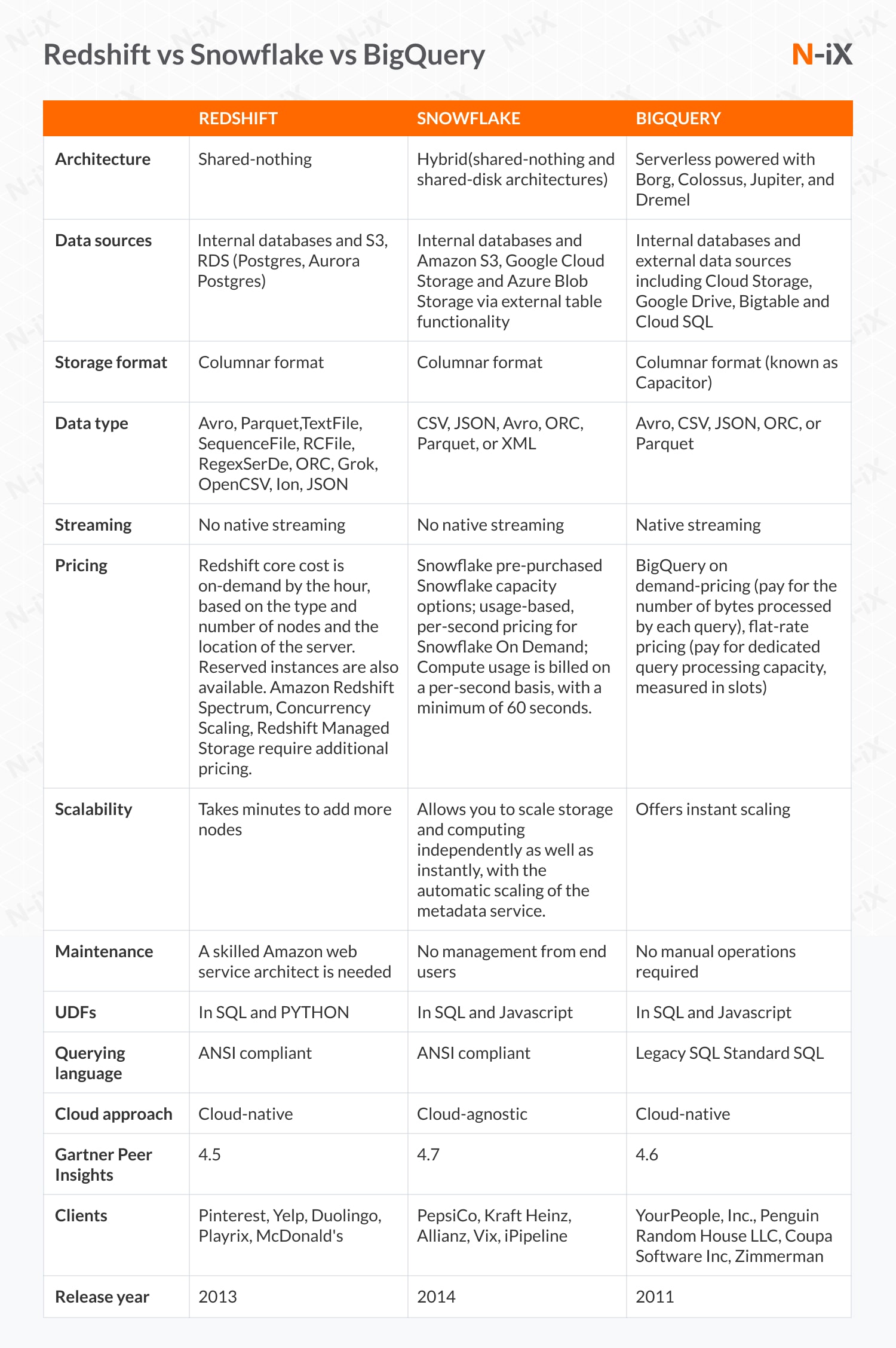An Overview: Understanding Redshift and Snowflake
Amazon Redshift and Snowflake are two leading cloud-based data warehousing solutions that have gained significant traction in the data management world. Both platforms provide robust, scalable, and secure environments for managing large volumes of structured and semi-structured data. The “difference between Redshift and Snowflake” has become a popular topic as businesses seek to optimize their data warehousing strategies.
Key Similarities: Two Data Warehouses Compared
Amazon Redshift and Snowflake share several fundamental similarities as cloud-based data warehousing platforms. Both solutions support SQL-based queries, ensuring compatibility with existing business intelligence (BI) and reporting tools. They also provide robust security features, including data encryption and user authentication, to protect sensitive information. Additionally, Redshift and Snowflake support data warehousing best practices, such as columnar storage, data partitioning, and indexing, to optimize query performance.
Core Differences: Architecture and Performance
The architectural differences between Redshift and Snowflake significantly impact performance, concurrency, and scalability. Amazon Redshift is a data warehouse built on a shared-nothing architecture, with each node responsible for a portion of the data. This design allows for massive parallel processing (MPP), delivering high performance for complex queries. However, Redshift’s performance may be affected by concurrent queries, as each query consumes resources from the available nodes.
In contrast, Snowflake utilizes a unique, serverless architecture that separates compute and storage resources. Snowflake automatically scales compute resources based on query complexity, ensuring consistent performance for concurrent queries. This architecture also enables Snowflake to scale storage independently, allowing for more efficient data management and lower costs.
Data Loading and Integration: A Crucial Comparison
Data loading and integration capabilities are essential factors when comparing Redshift and Snowflake. Both platforms support various data formats, including CSV, JSON, and Parquet, and provide connectors for popular data sources such as Amazon S3, Microsoft Azure, and Google Cloud Storage.
However, there are differences in data loading and integration processes. Redshift utilizes the COPY command for data loading, which can handle large volumes of data in parallel. Redshift also supports data refresh rates ranging from minutes to hours, depending on the data source and volume.
Snowflake, on the other hand, uses the COPY INTO command for data loading, which offers similar parallel processing capabilities. Snowflake supports near-real-time data loading through its continuous data loading feature, ensuring near-instant data availability. Snowflake also provides support for data refresh rates as low as a few seconds for specific use cases.
Pricing and Cost Management: A Key Decision-Making Factor
Pricing models significantly influence the total cost of ownership for both Redshift and Snowflake. Amazon Redshift offers on-demand and reserved pricing options, with on-demand pricing based on per-second usage and reserved pricing providing discounts for long-term commitments.
Snowflake operates on a pay-as-you-go model, charging for compute and storage resources separately. Snowflake also offers a credit-based system, providing flexibility for businesses with varying usage patterns. Factors such as data volume, query complexity, and concurrent users can significantly impact the overall cost for both platforms.
To ensure cost-effectiveness, organizations should consider factors like data storage requirements, query frequency, and user count when evaluating Redshift and Snowflake pricing models. Understanding these factors will help businesses make informed decisions about the most suitable platform for their data warehousing needs.
Security and Access Control: Ensuring Data Protection
Security and access control are essential aspects of any data warehousing solution. Both Amazon Redshift and Snowflake provide robust security features and access control mechanisms to protect sensitive data. These platforms ensure that organizations can meet various data protection requirements and secure their data effectively.
Amazon Redshift supports multiple security features, including VPC configuration, encryption at rest and in transit, and granular access control through IAM policies and user-based permissions. Redshift also offers column-level security and row-level security, enabling organizations to control access to specific data elements. These features help maintain the confidentiality, integrity, and availability of the data stored in Redshift.
Snowflake provides similar security features, such as always-on, enterprise-grade encryption, support for customer-managed keys, and fine-grained access control through role-based and resource-based permissions. Snowflake also supports multi-factor authentication (MFA) and integration with popular identity providers like Okta and Azure Active Directory. These security features help ensure that data within Snowflake remains secure and protected.
When evaluating Redshift and Snowflake, organizations should consider their specific security requirements and prioritize platforms that offer the necessary features and mechanisms to meet their data protection needs. Implementing robust security measures is crucial for maintaining the trust and confidence of customers, partners, and stakeholders in today’s data-driven world.
Unraveling the Distinction: Redshift vs. Snowflake
An Overview: Understanding Redshift and Snowflake
Amazon Redshift and Snowflake are two popular data warehousing solutions in today’s data management world. Both platforms have gained significant traction due to their ability to handle large volumes of data and support SQL-based queries. While they share similarities, there are critical differences that can impact an organization’s decision-making process.
Key Similarities: Two Data Warehouses Compared
Redshift and Snowflake are both cloud-based data warehousing platforms that support SQL-based queries. They offer easy scalability, minimal maintenance, and the ability to process massive data volumes. These similarities make them appealing options for businesses looking to modernize their data management strategies.
Core Differences: Architecture and Performance
Architecturally, Redshift and Snowflake differ in their approach to data storage and processing. Redshift uses a shared-nothing architecture, where data is distributed across multiple nodes, and each node processes a portion of the query. Snowflake, however, separates compute and storage resources, allowing for greater flexibility and fine-grained scaling.
Data Loading and Integration: A Crucial Comparison
Data loading and integration capabilities are essential when comparing Redshift and Snowflake. Both platforms support various data formats and offer connectors for popular data sources. However, they differ in data refresh rates and handling concurrent data loads.
Pricing and Cost Management: A Key Decision-Making Factor
Pricing models significantly influence the total cost of ownership for each platform. Redshift offers on-demand and reserved pricing options, while Snowflake operates on a pay-as-you-go model with a credit-based system. Understanding these differences is crucial for making informed decisions.
Security and Access Control: Ensuring Data Protection
Security features and access control mechanisms are vital for meeting data protection requirements. Both Redshift and Snowflake provide robust security features, including encryption, user authentication, and granular access control.
Use Cases and Industry Applications: Real-World Examples
Redshift and Snowflake are suitable for various data management scenarios. For instance, Redshift is often used in business intelligence, data lake architectures, and ETL workloads, while Snowflake excels in data science, machine learning, and real-time data warehousing.
How to Choose: A Comprehensive Evaluation Guide
When choosing between Redshift and Snowflake, consider factors such as architecture, performance, data loading, pricing, security, and use cases. Align these factors with your organization’s specific needs and priorities to make an informed decision.
Unraveling the Distinction: Redshift vs. Snowflake
An Overview: Understanding Redshift and Snowflake
Amazon Redshift and Snowflake are two popular data warehousing solutions in today’s data management world. Both platforms have gained significant traction due to their ability to handle large volumes of data and support SQL-based queries. While they share similarities, there are critical differences that can impact an organization’s decision-making process.
Key Similarities: Two Data Warehouses Compared
Redshift and Snowflake are both cloud-based data warehousing platforms that support SQL-based queries. They offer easy scalability, minimal maintenance, and the ability to process massive data volumes. These similarities make them appealing options for businesses looking to modernize their data management strategies.
Core Differences: Architecture and Performance
Architecturally, Redshift and Snowflake differ in their approach to data storage and processing. Redshift uses a shared-nothing architecture, where data is distributed across multiple nodes, and each node processes a portion of the query. Snowflake, however, separates compute and storage resources, allowing for greater flexibility and fine-grained scaling.
Data Loading and Integration: A Crucial Comparison
Data loading and integration capabilities are essential when comparing Redshift and Snowflake. Both platforms support various data formats and offer connectors for popular data sources. However, they differ in data refresh rates and handling concurrent data loads.
Pricing and Cost Management: A Key Decision-Making Factor
Pricing models significantly influence the total cost of ownership for each platform. Redshift offers on-demand and reserved pricing options, while Snowflake operates on a pay-as-you-go model with a credit-based system. Understanding these differences is crucial for making informed decisions.
Security and Access Control: Ensuring Data Protection
Security features and access control mechanisms are vital for meeting data protection requirements. Both Redshift and Snowflake provide robust security features, including encryption, user authentication, and granular access control.
Use Cases and Industry Applications: Real-World Examples
Redshift and Snowflake are suitable for various data management scenarios. For instance, Redshift is often used in business intelligence, data lake architectures, and ETL workloads, while Snowflake excels in data science, machine learning, and real-time data warehousing.
How to Choose: A Comprehensive Evaluation Guide
When choosing between Redshift and Snowflake, consider the following factors:
- Architecture and Performance: Assess how each platform’s architecture aligns with your performance, concurrency, and scalability requirements.
- Data Loading and Integration: Evaluate the data loading and integration capabilities, focusing on data formats, connectors, and data refresh rates.
- Pricing and Cost Management: Analyze the pricing models and estimate the total cost of ownership for each platform based on your data volume, query frequency, and user count.
- Security and Access Control: Compare the security features and access control mechanisms to ensure they meet your data protection requirements.
- Use Cases and Industry Applications: Consider the real-world examples and industry applications to determine which platform is more suitable for your specific data management scenarios.
By carefully evaluating these factors, you can make an informed decision about which platform best meets your organization’s unique needs and priorities.







